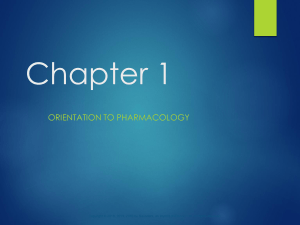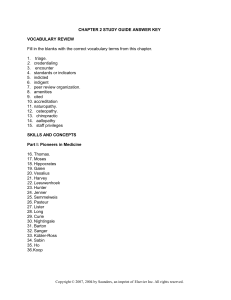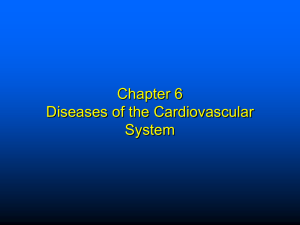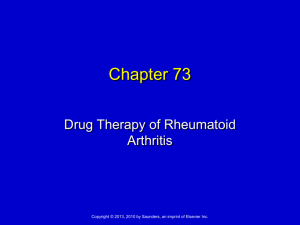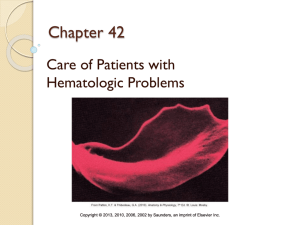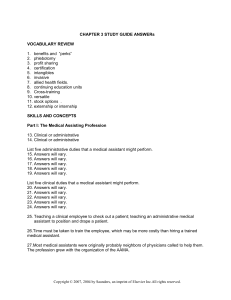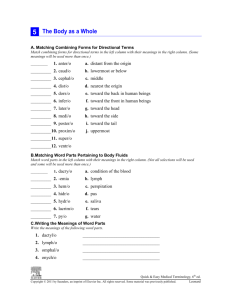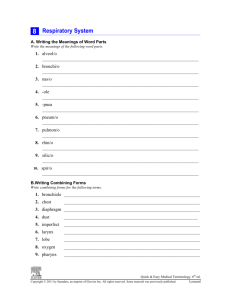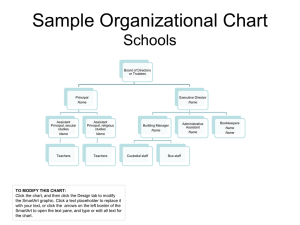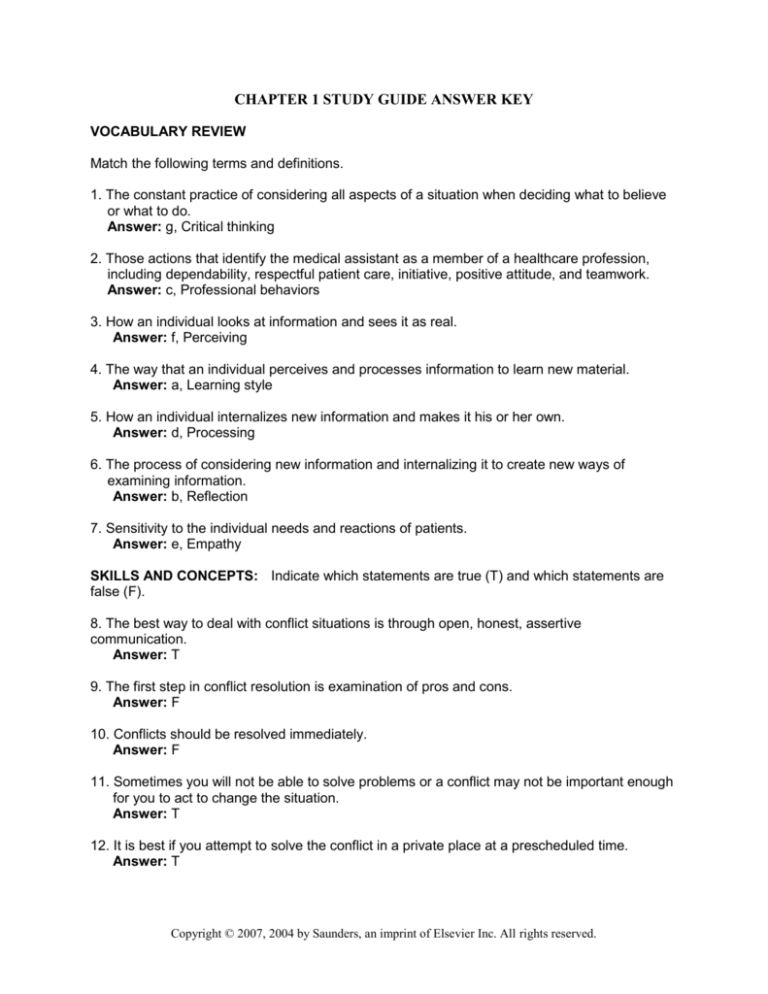
CHAPTER 1 STUDY GUIDE ANSWER KEY
VOCABULARY REVIEW
Match the following terms and definitions.
1. The constant practice of considering all aspects of a situation when deciding what to believe
or what to do.
Answer: g, Critical thinking
2. Those actions that identify the medical assistant as a member of a healthcare profession,
including dependability, respectful patient care, initiative, positive attitude, and teamwork.
Answer: c, Professional behaviors
3. How an individual looks at information and sees it as real.
Answer: f, Perceiving
4. The way that an individual perceives and processes information to learn new material.
Answer: a, Learning style
5. How an individual internalizes new information and makes it his or her own.
Answer: d, Processing
6. The process of considering new information and internalizing it to create new ways of
examining information.
Answer: b, Reflection
7. Sensitivity to the individual needs and reactions of patients.
Answer: e, Empathy
SKILLS AND CONCEPTS: Indicate which statements are true (T) and which statements are
false (F).
8. The best way to deal with conflict situations is through open, honest, assertive
communication.
Answer: T
9. The first step in conflict resolution is examination of pros and cons.
Answer: F
10. Conflicts should be resolved immediately.
Answer: F
11. Sometimes you will not be able to solve problems or a conflict may not be important enough
for you to act to change the situation.
Answer: T
12. It is best if you attempt to solve the conflict in a private place at a prescheduled time.
Answer: T
Copyright © 2007, 2004 by Saunders, an imprint of Elsevier Inc. All rights reserved.
Instructor’s Resource Manual
1-2
13. You need to understand the problem and gather as much information about the situation as
possible before you decide to act.
Answer: T
14. As a future member of the healthcare team, you will frequently face problems and conflict.
Answer: T
15. List five time-management skills.
Answer:
a. Determine your purpose
b. Identify your main concern
c. Be organized
d. Stop procrastinating
e. Remember you
Which of these do you think will require the most effort on your road to becoming a medical
assistant? How can you better prepare yourself for the challenges ahead?
Answer: Answers will vary.
16. Describe five strategies for breaking the cycle of procrastination.
Answer:
a. Make your work meaningful
b. Plan work deadlines
c. Ask for help
d. Prioritize
e. Reward yourself
What barriers cause you to procrastinate? How can you prepare yourself to avoid
procrastination?
Answer: Answers will vary.
Study Skills
Examine your own note-taking ability. Review the note-taking strategies in Chapter 1, and
record the ideas that you plan to incorporate into your academic goals for this term.
Answer: Have students write a short plan for their academic success. Have them sign it so that
they will feel committed to applying the new strategies.
CASE STUDIES
Read the case studies and answer the questions.
1. Dr. Weaver is running late seeing patients this afternoon. Sara Kline has been waiting in the
examination room for Dr. Weaver for 30 minutes. She peeks her head out of the examination
room doorway and demands to know what is taking so long. How should you, the medical
assistant, approach this patient? How do you calm her down and explain the physician’s
situation without compromising other patients’ confidentiality? What are some things you can
do for the patient to make the wait not seem so long?
2. Victoria Graham, a 68-year-old woman with diabetic retinopathy, arrives today for diabetes
disease management education. How might the medical assistant approach Ms. Graham's
Copyright © 2007, 2004 by Saunders, an imprint of Elsevier Inc. All rights reserved.
Instructor’s Resource Manual
1-3
learning style? What are some possible barriers, and how can the medical assistant help Ms.
Graham overcome them?
Student answers will vary.
WORKPLACE APPLICATIONS
1. You are the office manager for a busy family practice office. Over the past week you have
noticed that one of your employees has been 15 minutes late every day. Should you
approach this employee? If so, how would you manage the situation? What are the main
points you would want to stress to this employee? Are there any consequences? What
follow-up, if any should be done?
2. Physicians’ offices are extremely busy with many daily demands. How should one prepare for
proper time management? Why is it necessary to prioritize tasks? What are some ideas the
medical assistant can use to get the most out of the day and stay organized?
3. Connie is the manager of a busy family practice office. The insurance clerk has complained
that the receptionist takes too many smoking breaks and accepts too many personal calls
while at work. What type of information should Connie obtain before approaching the
situation? How should this situation be handled? Where? Who should be present?
4. After being on vacation for a week, Laura returns to the office to find her desk piled high with
tasks that require attention. Laura decides to get organized and make a list of the items that
need attention. Prioritize the tasks from “most important and urgent” to “needs to be done
later today” and “may be done later this week.” Explain your answers.
a. Make staff schedule for next week
b. Pull patient charts for the laboratory results the office received this morning for the
physician's review
c. Call and order immunization vaccines (the staff has informed you that they are on the
last vial)
d. Call and confirm the patient appointments for tomorrow
e. Order general stock supplies (e.g., bandages, gauze, needles, and sharps containers)
f. Review the insurance reimbursements the practice received for last month, and address
any claims that have not been paid
g. File charts
h. Edit the physician’s schedule for a meeting scheduled next month
CHAPTER 1 QUIZ
1. List three examples of professional behaviors.
Answer: Dependability, respectful patient care, empathy, initiative, and positive teamwork
2. Describe three way to use effective time management.
Answer: Determine your purpose, identify your main concerns, be organized, stop
procrastinating, remember you
3. Define procrastinatation, and describe how it is a barrier for time management.
Answer: Failing to work, or putting off your goals. By procrastinating, you fail to meet your
work deadlines and the work you do may not be your best.
Copyright © 2007, 2004 by Saunders, an imprint of Elsevier Inc. All rights reserved.
Instructor’s Resource Manual
1-4
4. ________________ is the process of sorting out conflicting information, weighing the
knowledge you possess about that information.
Answer: Critical thinking
5. What are some test-taking strategies you can recommend to other students?
Answer: Test-taking strategies include preparing adequately for the examination, controlling
negative thoughts during the examination, and understanding how to deal with different
types of questions.
6. Describe a “cycle map” and how it may be put into practice in your own life.
Answer: The cycle map in Figure 1-13 shows the connection among factors, such as with
the chain of infection. Creating your own mind maps is a way of making the information
more meaningful and easier for you to understand.
7. Compare and contrast the method of perceiving and processing.
Answer: Perceiving is how an individual looks at information and sees it as real.
Processing is how an individual internalizes new information and makes it his or her own.
Copyright © 2007, 2004 by Saunders, an imprint of Elsevier Inc. All rights reserved.



